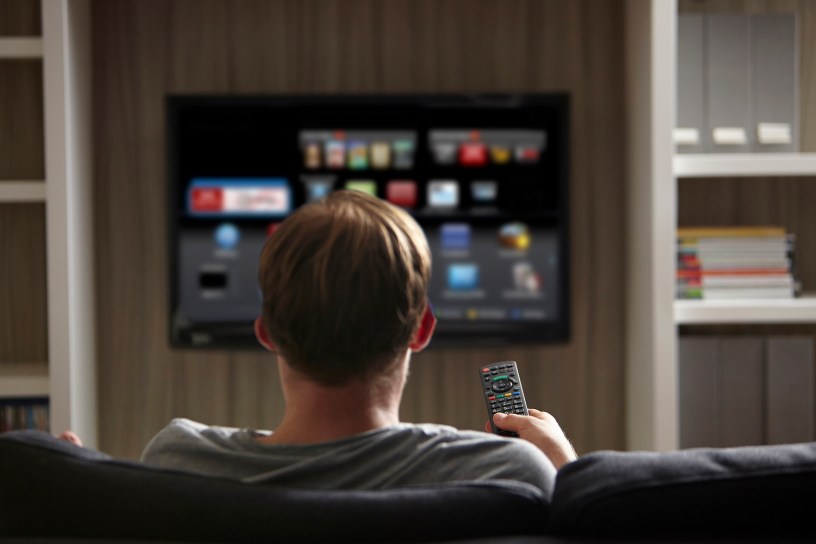RMIT media researchers Ramon Lobato, Alexa Scarlata and Bruno Schivinski write that the government’s planned overhaul of TV prominence rules may change the way we discover content on our smart TVs.
Two thirds of Australian adults now have a smart TV at home, and that number is rising every year.
If you are one of these users, then you know that content discovery on a smart TV works fundamentally differently from traditional broadcast television.
With their home screens full of algorithmic recommendations and sponsored content, smart TVs give the TV manufacturer control over installed services. In effect, this means companies like Samsung, LG and Hisense can now determine the apps, recommendations, search results and home-screen ads that you see when you turn on your device.
It also means that prime positions (such as home screen tiles and shortcut buttons) can be sold to the highest bidder – most commonly, to Netflix, Disney+, and other US-based streaming services.
The end result is that many TVs now aggressively push content from their commercial partners, with biased search results and recommendations designed to favour those services.
The broadcaster backlash
Australia’s free to air broadcasters are not happy about this situation, and have been warning the government that local linear TV channels and apps like ABC iview and 10Play “are becoming difficult for Australians to find as TV manufacturers sell prominent spots on user interfaces”.
The government is listening carefully to the broadcasters’ complaints, as it usually does. Communications Minister Michelle Rowland has recently released a Proposals Paper describing policy options to improve the visibility, or “prominence”, of Australian apps (iview, SBS On Demand, 7Plus, 9Now, and 10Play) and local content on smart TVs.
No final decisions have been made by government, with submissions due by February 24 – but the outcome of this could very well shape how future generations of Australians discover content on their smart TVs. This prominence regulation – together with the streaming quotas anticipated as part of the National Cultural Policy – means the stage is set for a significant reshaping of television regulation in Australia.
The prominence problem
The Proposals Paper sets out four possible ways that a local TV prominence framework could be designed and applied in Australia.
The first option is a mandated reporting scheme under which manufacturers and platform operators would need to describe the measures they have in place to ensure the prominence of local TV services.
The second proposal is a fair bargaining framework, which would require the technical and commercial terms of access to regulated TV devices to be ‘fair and reasonable’, and for TV services and devices to engage in ‘good faith’ negotiations.
The third option is a must-carry framework that would require regulated TV devices to carry – that is, make available – local TV services at no cost. The Proposals Paper sets out the different ways that ‘minimum access requirements’ could be met, such as requiring local free-to-air TV apps to be pre-installed and visible on the home screen from setup.
The last, and most onerous, proposed model is a must-promote framework. More extensive than the must-carry rules, this would require the broadcasters’ apps be not only pre-installed but also positioned before other apps like Netflix, YouTube, and Disney+ on every smart TV home screen. Under this framework, broadcaster content would also receive ‘positive discrimination’ in recommendations and search results on regulated TV devices.
These four models represent increasing levels of regulatory intervention and as such will find support from different stakeholders. The first, ‘light touch’ proposal will be most amenable to TV device manufacturers keen on maintaining the commercial deals they have struck with content providers (their ‘pay-for-prominence’ revenue stream). On the other hand, local broadcasters will likely advocate for the third or fourth options to ensure the free pre-installation and promotion of their apps and the content they offer.
Towards transparency
In our view, a must-carry rule requiring compulsory pre-installation of broadcaster apps is the best regulatory solution to this problem. If carefully implemented, it will improve consumer access to local services without biasing recommendations or unreasonably distorting the market.
However, there is more that can be done to protect audiences and support local content. While government attention is presently focused on broadcaster prominence and local content quotas, we must not forget the other policy issues that need attention in this space.
One of these is advertising. At present, ads on smart TV home screens (for example, top-of-screen masthead banners promoting a show or app) are often unlabelled and therefore not easily distinguishable from personalised content recommendations.
This is a problem for consumers. In our research, we found that 55 per cent of smart TV users could not correctly distinguish between a paid advertisement and a personalised recommendation on a smart TV home screen.
The government should therefore move forward with the ad labelling rules only briefly flagged in the Proposals Paper, and ensure these are adequately enforced. But it also needs to encourage a higher degree of transparency and fairness in smart TV recommendations generally.
In this sense, a wider prohibition on unfair practices, as recommended by the ACCC in its digital platform services inquiry, would be beneficial. This would reduce self-preferencing in recommendations (e.g., Google TV promoting YouTube over other relevant services), which annoy users and obstruct our access to the content we want to see.
In summary, the current “wild west” environment in smart TV platforms – where unlabelled home-screen ads, preinstalled apps, priority recommendations, boosts in search results, and other forms of prioritisation are being sold to the highest bidders – needs to be brought under regulation. The government’s prominence proposals are a step in the right direction, but more can be done to ensure Australian audiences can enjoy their smart TVs with a minimum of commercial interference.
Associate Professor Ramon Lobato, Dr Alexa Scarlata and Dr Bruno Schivinski are researchers at RMIT University’s School of Media and Communication and ADM+S Centre.



